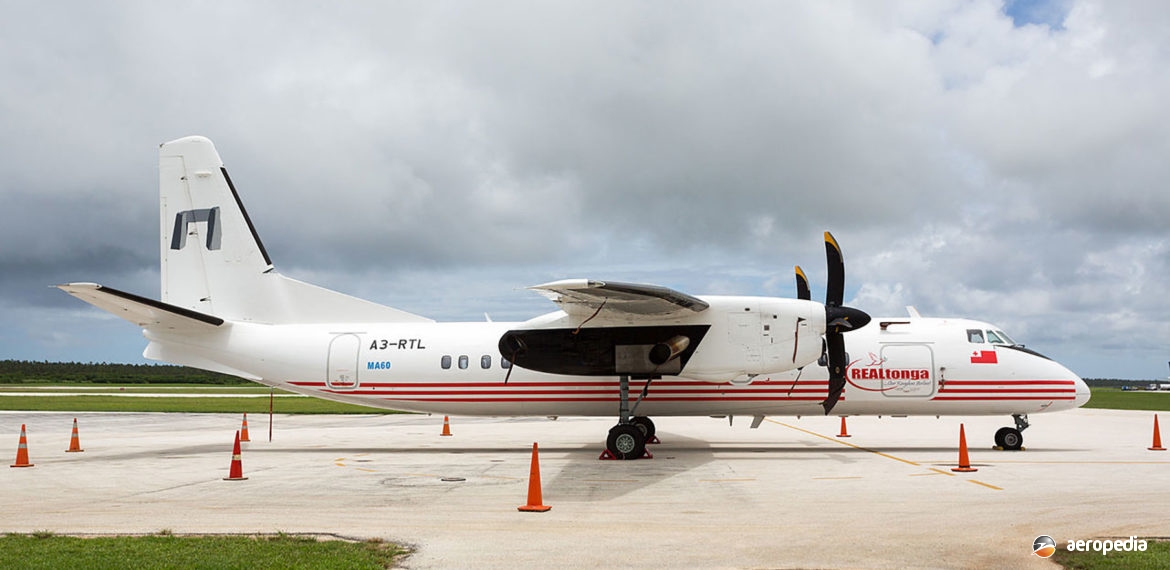Photograph:
Xian MA-60 A3-RTL at Tonga on arrival (Real Tongan Airlines)
Country of origin:
China
Description:
Twin-engine commercial airliner
Power Plant:
Two 2,051 kw (2,750 shp) Pratt & Whitney Canada PW-127J turboprops
Specifications:
- Wingspan: 28.20 m (95 ft 9½ in)
- Length: 24.71 m (81 ft 0¾ in)
- Height: 8.86 m (29 ft 0½ in)
- Wing area: 75.0 m² (807 sq ft)
- Max speed: 514 km/h (319 mph)
- Economical cruising speed: 430 km/h (267 mph)
- Service ceiling: 7,620 m (25,000 ft)
- Range: 1,600 km (994 miles)
- Empty weight: 13,700 kg (30,203 lb)
- Loaded weight: 21,800 kg (48,060 lb)
History:
The MA-60 is a turboprop powered 52-seat commercial transport designed and built by the China Aviation Industry Corporation and is a stretched and re-designed variant of the Y7-200A, which itself was produced in China as a development of the Antonov An-24 transport, which had been designed to operate in rugged conditions with only limited ground support and which had a STOL (short take-off and landing) capability.
The type received Type Certification in China from the local Civil Aviation Administration in June 2000 but since then the type has not received certification by the United States FAA, and no other western Government has issued a Type Certificate.
The MA-60 entered service in August 2000 with Sichuan Airlines and has continued in production since then. By March of 2013 80 of the 210 on order had been completed and delivered. Variants include the MA-60-100 which has reduced weight and an improvement in performance; the MA-60-MPA Fearless Albatross for maritime patrol and anti-submarine warfare, this variant being offered on the market in 2002; and the MA-40, which has reduced capacity to 40 seats. The type is in operation with a number of airlines and air forces around the world. It has been said the MA-60 suffered a series of accidents since 2009 and several operators have grounded the type.
In 2013 the Chinese Government donated an MA-60 (A3-RTL – c/n 904) to the Tongan Government which then leased the aircraft for operation by Real Tonga. In July 2013 the New Zealand Government suspended its aid program to the Tongan tourism industry and issued a statement that tourists should not travel on the MA-60 as the aircraft had been involved in a significant number of accidents. However, in most accidents the cause was attributed to “aircrew error” rather than a failure of the aircraft or its systems. The type was not certified to fly in New Zealand and the New Zealand Government stated it would continue to withhold a tourism development aid package for Tonga until the MA-60 was certified by a respected international authority. An offer by New Zealand to fund an aviation safety expert to travel to Tonga and assess the aircraft was rejected by the Tongan Government. The Tongan Minister for Infrastructure, and also Deputy Prime Minister, who is responsible for transport, stated he could not allow a third-party assessment because “it will be bad for our diplomatic relations with China”.
The Chinese Government also offered to the airline, Real Tonga, two new HAI Y-12s for domestic air services for delivery in 2015. The MA-60 was certified in June 2012 in Tonga and commenced domestic services between Tongatapu and the northern Island of Vava’u on 10 August 2013.
In mid-2014 Real Tonga Airlines stated it would cease operations with its MA-60 pending a decision on its future and at the same time wet-leased two Jetstream 32s from Fly Pelican Airlines in Australia to cover the loss of the use of this aircraft. In the meantime pilots and engineers left for China to undergo training on a new variant of the Harbin Y-12 which was gifted to the Tongan Government. Real Tonga had experience with the Y-12, having leased an Air Vanuatu Y-12 for a period as YJ-AV4 (c/n 028), which itself had been leased to Palu Aviation Services Ltd.
In December 2015 the Tongan Government stated it was adopting New Zealand standards for the certification of the MA-60 but further details of the agreement were not released at that time. However, it seems that after the aircraft arrived in Tonga an “aviation expert” wrote a story in a New Zealand newspaper stating the aircraft was unsafe and the NZ Government Minister stated aid would be cut from Tonga if the aircraft was put into service. The claim was the type had been involved in many accidents in the approach and landing phase, which was said to be a not unusual occurrence in Asia. The bad-publicity lead to Real Tonga losing its lease of the aircraft which was handed over to a new lessor.

